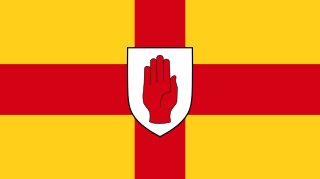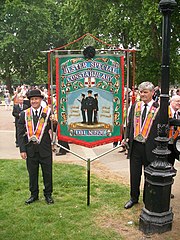
Ulster is one of the four traditional or historic Irish provinces. It is made up of nine counties: six of these constitute Northern Ireland ; the remaining three are in the Republic of Ireland.

The Battle of the Boyne took place in 1690 between the forces of the deposed King James II, and those of King William III who, with his wife Queen Mary II, had acceded to the Crowns of England and Scotland in 1689. The battle was fought across the River Boyne close to the town of Drogheda in the Kingdom of Ireland, modern-day Republic of Ireland, and resulted in a victory for William. This turned the tide in James's failed attempt to regain the British crown and ultimately aided in ensuring the continued Protestant ascendancy in Ireland.
The Ulster Scots, also called Ulster Scots people or, in North America, Scotch-Irish (Scotch-Airisch) or Scots-Irish, are an ethnic group in Ireland, who share a common history, culture and ancestry, some of whom speak an Ulster Scots dialect of the Scots language, a West Germanic language. As an ethnicity, they descend largely from Scottish and English settlers who moved to the north of Ireland, during the 17th century.

The Apprentice Boys of Derry is a Protestant fraternal society with a worldwide membership of over 10,000, founded in 1814 and based in the city of Derry, Northern Ireland. There are branches in Ulster and elsewhere in Ireland, Scotland, England, Australia and Toronto, Canada. The society aims to commemorate the 1689 Siege of Derry when Catholic James II of England and Ireland and VII of Scotland laid siege to the walled city, which was at the time a Protestant stronghold. Apprentice Boys parades once regularly led to virulent opposition from the city's Irish nationalist majority, but recently a more conciliatory approach has taken place and now the parades are virtually trouble-free. The 2014 'Shutting of the Gates' parade was described as "the biggest in years" and was violence-free.

The Twelfth is a primarily Ulster Protestant celebration held on 12 July. It began in the late 18th century in Ulster. It celebrates the Glorious Revolution (1688) and victory of Protestant King William of Orange over Catholic King James II at the Battle of the Boyne (1690), which ensured a Protestant Ascendancy in Ireland. On and around the Twelfth, large parades are held by the Orange Order and Ulster loyalist marching bands, streets are plastered with union jacks and bunting, and large towering bonfires are lit in loyalist neighbourhoods. Today the Twelfth is mainly celebrated in Northern Ireland, where it is a public holiday, but smaller celebrations are held in other countries where Orange lodges have been set up.

Ireland during the period of 1536–1691 saw the first full conquest of the island by England and its colonization with mostly Protestant settlers from Great Britain. This would eventually establish two central themes in future Irish history: subordination of the country to London-based governments and sectarian animosity between Catholics and Protestants. The period saw Irish society outside of the Pale transform from a locally driven, intertribal, clan-based Gaelic structure to a centralised, monarchical, state-governed society, similar to those found elsewhere in Europe. The period is bounded by the dates 1536, when King Henry VIII deposed the FitzGerald dynasty as Lords Deputies of Ireland, and 1691, when the Catholic Jacobites surrendered at Limerick, thus confirming Protestant dominance in Ireland. This is sometimes called the early modern period.

A Williamite was a follower of King William III of England who deposed King James II and VII in the Glorious Revolution. William, the Stadtholder of the Dutch Republic, replaced James with the support of English Whigs.

The Loyal Orange Institution, commonly known as the Orange Order, is an international Protestant fraternal order based in Northern Ireland and primarily associated with Ulster Protestants. It also has lodges in England, Scotland and the Republic of Ireland, as well as in parts of the Commonwealth of Nations and the United States. The Orange Order was founded by Ulster Protestants in County Armagh in 1795, during a period of Protestant–Catholic sectarian conflict, as a fraternity sworn to maintain the Protestant Ascendancy in Ireland. The all-island Grand Orange Lodge of Ireland was established in 1798. Its name is a tribute to the Dutch-born Protestant king William of Orange, who defeated Catholic king James II in the Williamite–Jacobite War (1689–1691). The Order is best known for its yearly marches, the biggest of which are held on or around 12 July, a public holiday in Northern Ireland.
Murals in Northern Ireland have become symbols of Northern Ireland, depicting the region's past and present political and religious divisions.
The culture of Belfast, much like the city, is a microcosm of the culture of Northern Ireland. Hilary McGrady, chief executive of Imagine Belfast, claimed that "Belfast has begun a social, economic and cultural transformation that has the potential to reverberate across Europe." Belfast is split between two rarely-overlapping vibrant cultural communities, a high-culture of opera, professional theatre, filmmaking and the visual arts and a more popular or commercial culture. Throughout the short years of troubles, Belfast tried to express itself through art and music. Hi In the second decade of the twenty-first century, the city has a growing international cultural reputation
Parades are a prominent cultural feature of Northern Ireland. The overwhelming majority of parades are held by Ulster Protestant, unionist or Ulster loyalist groups, but some Irish nationalist, republican and non-political groups also parade. Due to longstanding controversy surrounding the contentious nature of some parades, a quasi-judicial public body — the Parades Commission — exists to place conditions and settle disputes. Although not all parading groups recognise the Commission's authority, its decisions are legally binding.
The Loyal Orange Institution, better known as the Orange Order, is a Protestant fraternal order based in Northern Ireland. It has been a strong supporter of Irish unionism and has had close links with the Ulster Unionist Party, which governed Northern Ireland from 1922 to 1972. The Orange Order has lodges throughout Ireland, although it is strongest in the North. There are also branches throughout the Commonwealth, and in the United States. In the 20th century, the organisation went into sharp decline outside Northern Ireland and County Donegal. Observers have accused the Orange Order of being a sectarian organisation, due to its goals and its exclusion of Roman Catholics and close relatives of Catholics as members. The Order has a substantial fraternal and benevolent component.

Orange walks, or Orange marches, are a series of parades by members of the Orange Order and other Protestant fraternal societies, held during the summer months in various Commonwealth nations, and most notably across Ireland. The parades typically build up to 12 July celebrations marking Prince William of Orange's victory over King James II & VII at the Battle of the Boyne in 1690.
Ulster Protestants are an ethnoreligious group in the Irish province of Ulster, where they make up about 43.5% of the population. Most Ulster Protestants are descendants of settlers who arrived from Britain in the early 17th century Ulster Plantation. This was the settlement of the Gaelic, Catholic province of Ulster by Scots and English speaking Protestants, mostly from the Scottish Lowlands and Northern England. Many more Scottish Protestant migrants arrived in Ulster in the late 17th century. Those who came from Scotland were mostly Presbyterians, while those from England were mostly Anglicans. There is also a small Methodist community and the Methodist Church in Ireland dates to John Wesley's visit to Ulster in 1752. Although most Ulster Protestants descend from Lowland Scottish people, many descend from English, and to a lesser extent, from Irish, Welsh and Huguenots.

The siege of Carrickfergus took place in August 1689 when a force of Williamite troops under Marshal Schomberg landed and laid siege to the Jacobite garrison of Carrickfergus in Ireland. After a week the Jacobites surrendered, and were allowed to march out with the honours of war.
Sir Charles Carney was an Irish professional soldier, who later in his career became a Jacobite. He served as an officer in the Irish Army of James II during the Williamite War in Ireland.

The Battle of the Boyne is a 1778 historical painting by the Anglo-American artist Benjamin West. It portrays the Battle of the Boyne which took place in Ireland in 1690. West's depiction of William of Orange on his white horse became the iconic image of liberation from Catholic Ireland; the painting was widely copied and distributed throughout the nineteenth century. The painting itself is at Mount Stewart, Newtownards, Northern Ireland, and is the property of the National Trust.
The Capture of Bandon occurred in 1689 when the town of Bandon in County Cork, Ireland was forcibly seized from its rebellious Protestant inhabitants by a force of Irish Army troops under Justin McCarthy. The skirmishing at the town took place during the early stages of the Williamite War in Ireland. The Jacobite success at Bandon helped suppress any chance of a general Munster uprising against the rule of James II similar to that which occurred in Ulster the same year. The slogan "No Surrender!" is believed to have been first used at Bandon and subsequently taken up, more famously, by the defenders at the Siege of Derry the same year.

The flag of the Orange Order, also known as the Boyne Standard, or the Orange Standard, is the flag used by a Northern Irish Protestant fraternal organisation, the Orange Order. The flag consists of an orange background with a purple star and a Saint George's Cross in canton.















